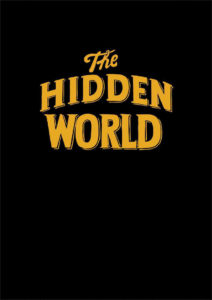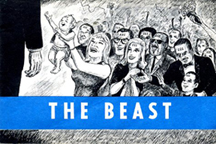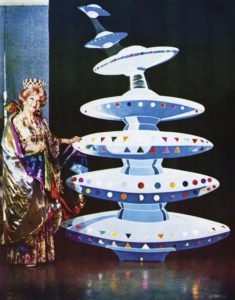Jim Shaw: The Hidden World, edited by Marc-Olivier Wahler. Koenig Books, London, 512 pages, 2014. ISBN: 978-3863355845. Hardcover.
 Jim Shaw’s collection of religious, political and cultural ephemera, published in 2014 as an exhibition catalog, makes for a great book, especially if your collecting interests align with Shaw’s, as mine not coincidentally do.
Jim Shaw’s collection of religious, political and cultural ephemera, published in 2014 as an exhibition catalog, makes for a great book, especially if your collecting interests align with Shaw’s, as mine not coincidentally do.
This little volume is packed with material relating to eccentric religion, UFOs, cults and other marginal (or should-be marginal) human endeavors, just like my attic. These posters, magazines, leaflets, books, comics and bits of eccentricity are source materials that illuminate Shaw’s work and should interest people who care about it.

Some of us have have no art to make and collect this stuff strictly for personal delight in its weirdness – be it Jack Chick’s fundamentalist paranoia or the UFO-obsessed Unarius Society’s joyful fantasies. That’s also a good reason to care about Shaw’s collection.
The book intersperses generous selections from his archive with interviews in which he shares some of what he knows about the people who produced the material and what they were trying to communicate. The attitude he projects is, if not exactly respectful, at least deadpan. There is no need to make fun of this stuff; it can tell its own story without a heavy overlay of irony.

Notions that may initially seem simply odd can end up having serious purpose and content, or at least implications. Even crazy ideas can inspire incredible works of art. They might still be weird, but if you see only the weirdness you risk missing the point. And while the fantasies of UFO enthusiasts might be implausible, these folks nonetheless have spent a lot more time than most of us thinking about the nature and implications of extraterrestrial life and thus might have some actual insights to share, in addition to the sometimes-beautiful visualizations.
Even more to the point, the beliefs of a far-right cult like the John Birch Society have turned out to have had far more influence on our country than the communist conspirators they thought were running the world back in the 1960s. Understanding the Birchers can help us understand the Trumpers. Similarly, the anti-modern world view that Jack Chick laid out in his comic books tells us a lot about the secret beliefs of the religious right, beliefs more common today than anyone would have expected when he was selling them in the 1970s.
Social significance aside, I have a personal sense of connection to Shaw and his interests. For many years I’ve related a story about how I came to start collecting art: Sometime in 1981 my late friend Mark Williams told me about a Cal Arts friend of his who was finding really cool pictures in thrift stores – specifically he mentioned paintings of robots doing crazy things, like playing football. I was already spending lots of time in thrift stores looking for records, books, vintage clothes and assorted kitsch objects. Adding paintings to that list seemed to make sense. Then, on my first thrifting visit after our conversation (to the Catholic Charities thrift store in Santa Barbara),  I found what is still one of my all-time favorite paintings, “Spectacular Display in Night Sky.”
I found what is still one of my all-time favorite paintings, “Spectacular Display in Night Sky.”
My collecting interest eventually included many more kinds of art than could be routinely found in thrift stores, but it was thrift store art that got me started. And that was thanks to Shaw, as I discovered when his Thrift Store Paintings collection came to Chicago in 1991, including those robot pictures. I asked Mark if that Cal Arts friend was Shaw, and of course it was.
Reading this little book revealed another connection. Although I had come upon Jack Chick on my own and started collecting his comics in high school, it was Mark who first told me about the Unarius Society, and I’ve no doubt that Mark’s knowledge of the Unarians was tied to the same Jim Shaw connection. So thanks Jim.

The best of both worlds: thrift-store UFO paintings.
-
- Some miscellaneous weirdness on


I like Jim Shaw a lot. Thanks for your post.